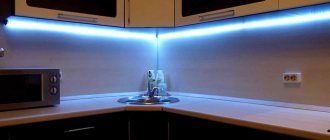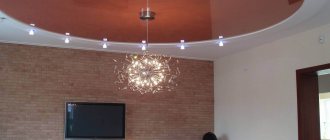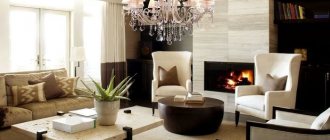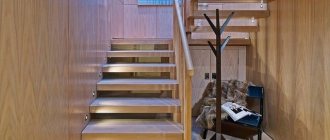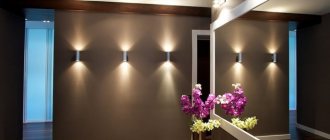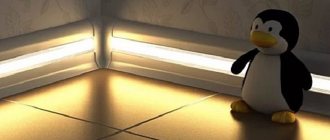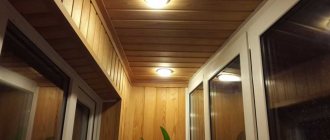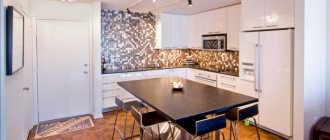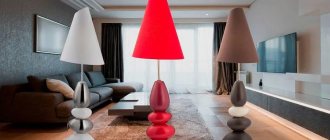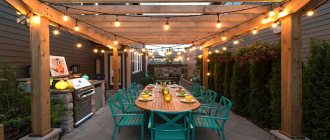Bright, soft, strong, not harsh - LEDs have proven that artificial lighting can combine these seemingly different qualities. Today you won’t surprise anyone with multi-colored LED cords and strips; they decorate facades and windows, shop windows and signs, but in the home, such decor began to be used relatively recently. It is unknown who first came up with the idea of incorporating an even, plastic glow into the home interior, but the idea turned out to be surprisingly tenacious.
LED lighting in the interior
Features and functions of LED backlight
LED lamps can be said to have eclipsed traditional lamps and surpassed them in a number of characteristics:
- they are more economical;
- their service life is significantly longer;
- they are durable and compact;
- their temperature is lower;
- their brightness is easy to adjust;
- they do not require special color filters;
- Finally, LED lamps can serve as an excellent interior component.
It is not surprising that LED lighting is rapidly replacing other types, and new houses are being built either with the expectation that they will be equipped with LED lighting, or with already built-in LED lamps.
However, “flexible neon,” as such lighting is sometimes called “popularly,” has not only a colorful and elegant role; in the interior it performs various functions:
- LED lamps and strips illuminate steps, openings and corridors, making them more visible, for example, at dusk;
- contour lighting zones the room, divides it into parts;
- by highlighting niches, moldings, cornices and mirrors, they visually add volume to the room;
- with the help of LEDs, decorative accessories are highlighted, focusing attention on the necessary items;
- Thanks to LED cords and strips, you can realize a huge number of artistic ideas and make the interior unique.
Options for suspended ceilings
This type of ceiling is equipped with several types of lamps. The only distinguishing feature is the depth of installation of live parts. The use of mortise lighting devices is most important, and a ring is attached around the lamps to prevent the film from tearing.
Above ceiling level
Lighting fixtures installed above the ceiling create the effect of glowing from within. It looks great, but it has a number of disadvantages:
- the area is not fully illuminated;
- the lamps may become very hot;
- the need to use LED lamps.
At ceiling level
Recessed spotlights are installed directly into the ceiling structure itself. The lighting of the space is carried out depending on the idea. But the light dispersion coefficient is quite high. Lamps with a power exceeding 35 W cannot be installed, and a transformer must be installed.
Below level and overhead
The main distinguishing characteristics of such lighting are a large percentage of light dispersion. This category includes spotlights that are also built into a suspended or suspended structure, but the lighting element extends beyond the ceiling. They may have glass shades and hanging decorative elements.
For the installation of surface-mounted lamps, a special base is used, which allows the use of lamps of different power ratings.
Other options
Using fiber optic spotlights, you can create an imitation of the starry sky. Two-level stretch ceilings with additional lighting are quite original in their solution. It is worth considering that when choosing minion type lamps, one element is installed per 2 m2.
Types of LED backlights
Mostly duralights and LED strips are used to decorate home interiors.
Duralights are translucent colored or completely transparent flexible silicone cords filled with small LED light bulbs in the form of a garland. They can be secured using special transparent plastic brackets. LED strips are flat boards in the form of strips, which are most often sold in reels. Almost all LED strips have an adhesive backing on the back side; this is done for ease of installation. The tapes are ordinary and moisture-resistant; they can change not only the brightness and strength of the emitted light, but also the shades.
In addition to strips and duralights, manufacturers offer various LED devices, panels and even glass blocks, transparent and matte, with LED backlighting. Connecting LED lighting is not at all difficult - however, you will have to buy a special power supply (adapter) along with the strip.
Kitchen
This room places the highest demands on lighting. If the lack of artificial light in the living room is not a fatal mistake, then in the kitchen incorrectly installed lighting causes a lot of inconvenience. Thus, light rays directed from behind and from above relative to a standing person give a thick shadow to the working surface. As a result, you have to strain your eyes, lean lower over the cutting board, and protect your fingers from cuts. Therefore, the closest attention must be paid to the placement of lamps in the kitchen. What rules and recommendations are there?
- It is not customary to hang too luxurious chandeliers in the kitchen, since the room is not large in size, and it is difficult to put numerous decorative details in order. Therefore, experts recommend giving preference to ceiling or recessed lamps with a laconic design. They provide even, diffused light, which is very important when working in the kitchen. You can choose both single-lamp models and multi-lamp models with several shades. Hanging chandeliers are chosen exclusively for high ceilings.
- In the kitchen there are usually at least two functional areas - a working and a dining room. Therefore, it makes sense to purchase not one, but several central lamps, distributing them in accordance with the designated areas. They may be the same, or radically different in design.
- The work area is often illuminated with spots or tracking systems. They are very convenient as they allow you to direct and enhance light flows at a certain point. And for the recreation area, elegant hanging products and wall sconces are suitable.
- Models with the ability to adjust the height of the lampshade and several brightness modes are an ideal option for the kitchen. They allow you to create exactly the lighting that is required at the moment.
- Even, soft light around the entire perimeter of the work area is provided using an LED strip mounted on the lower edge of the upper tier of wall cabinets.
- Spot lights mounted on top of hanging cabinets provide excellent illumination for the countertop, stove and sink. Spot and built-in lamps located at the junction of the kitchen apron and the upper tier of cabinets, on their lower surface, serve the same purpose.
If the kitchen is spacious enough, you can complement the composition with an interesting floor lamp located next to the dining group or seating area.
Ways to use LED backlight
You can decorate your home with LED edging, starting right at the doorstep. Or even behind him, outside. If you have good spatial vision, then using LEDs on strips and cords, you can completely “redraw” the space, make the room appear taller or wider. And, of course, more intimate, because LED lamps are a source of diffused, delicate light.
Let's look at the most popular and, conversely, the most unusual LED tricks.
Cornered ceiling lighting magically transforms a room when it comes to tension, multi-level structures. It “lifts” and at the same time fills the space with a calm, glare-free light, reminiscent of dawn or sunset.
Niches and lighting are literally made for each other: the illumination built into the recesses produces a magical impression because only the blurry light is visible, but not its source.
Mirrors framed with LEDs acquire special depth and visually expand the walls. It is permissible to use such a dramatic technique in the hallway, in the living room, and even in the bathroom. With a moisture-resistant LED strip, you can safely decorate an aquarium or a portable fountain in the living room: it will be difficult to tear your enchanted gaze away from the combination of water and light.
An LED strip stretched between the dining room and living room or dining room and kitchen will delimit these two zones and emphasize their autonomy.
On the ceiling of the bedroom, using LEDs, you can depict a “starry sky”, lay out the outline of the constellations or the signs of the Zodiac with a flexible cord... In any case, delicate lighting in the bedroom can be a very good solution.
LED lighting is environmentally friendly and safe, which means it is also suitable for children’s decor.
It will not only form a slightly mysterious, magical halo, but will also play the role of a night light with unobtrusive light. “Draw” with LEDs a scattering of fireflies on the wall or a winter tree. Cover the part of the room where the toys are concentrated with flexible luminous tape, and your baby will have magical dreams.
LED cords are so versatile that they are increasingly being used to decorate furniture. Moreover, pieces of furniture already equipped with LED lighting have appeared on sale.
The luminous ribbon will duplicate the curves of the original chair, the elegant shapes of the sofa, and the bed, decorated with lighting, will also acquire the qualities of a lamp.
In the bathroom, using LEDs, you can imitate the glow of candles or lay out the outlines of strange fish, starfish and algae with colored cords. In the kitchen, “flexible neon” illuminates the work surface. Or they combine two types of lighting: bright at the top, above the cabinets, and dim at the bottom, under them. An aesthetically good idea is to outline the bar counter with an LED border.
A real extravaganza is achieved when LED lighting is combined with glass objects. This could be some very simple option, for example, the shimmering perimeter of a glass door or door... Or light accentuation of a rack with decorative accessories, a glass display case with dishes, or a table top.
LED lighting can be hidden behind plasterboard panels by cutting out patterns in them and covering them with colored, translucent fabrics. The result will be an amazingly beautiful “theater of shadows and light.”
With the help of LEDs, many glass objects are turned into floor lamps. A stork floor lamp, a tree floor lamp, a column floor lamp... LEDs are a magic wand that transforms a piece of glass into the moon, a firebird feather or a block of ice illuminated by the northern lights.
In addition, with the help of lighting of one shade or another it is easy to add imaginary warmth or coolness, romanticism or passion, efficiency or sincerity to the home.
Ceiling lighting ideas for different rooms
Today there are many ways to decorate a ceiling using light. When choosing, you should take into account the purpose of the room and what characteristics the lighting fixtures have.
Corridor
A few recommendations for corridor lighting:
- For low ceilings, it is recommended to place lamps with a given direction of light towards the walls and upwards in order to increase the volume of the room.
- If the ceiling level is below average, then the effects of original lighting are achieved using halogen devices.
- To expand the space, lamps should be built in and mounted so that the light falls on the walls.
- If the ceiling level is high, then you can install several hanging lighting fixtures, so the light will fall on the floor.
Related article: Lighting in the corridor: stylish solutions for large and small apartments (+62 photos)
Kitchen
The main or general lighting required for this room is used, additional - local in the form of spotlights, wall sconces. The first type is usually used to illuminate the entire area, and the second in the place of preparation or eating.
Bedroom
Before installing lighting fixtures, you need to make sure where the bed will be located; the routing of the wire depends on this. It is recommended to place the main lighting in the center of the room; you can use a regular chandelier, and hang a night lamp with a halogen lamp on the wall near the bed.
Living room
The main lighting element can be a chandelier located in the center of the room, but it is important to take into account the parameters of the area and the height of the ceiling. If the room is large, then an oversized chandelier will look original. If the living room is small, then the ceiling can be decorated with built-in lamps to visually expand the space.
Bathroom
The ideal solution would be matte or transparent shades. If the ceiling level is very high, then you can hang a chandelier, and if it is low, then it is enough to fix the lamps to the walls. It is worth noting that the selected materials made of colored glass will not be the best option, since the flow of light will be distorted.
Balcony
There is little space in this area, so you can use:
- small table lamp;
- ceiling light source;
- wall placement of sconces.
Usually, for lighting on a balcony or loggia, the choice is made in favor of devices designed for the street.
"Flexible neon" and matching styles
LED lighting will fit perfectly into many interior styles, highlighting their character and enhancing their color. For example, a cold, cosmic glow is suitable for high-tech, especially if the backlight is used to outline a plasma screen, home theater, or panoramic window. The shining lines, however, should remain strict, deliberately sharp. The interior, illuminated in this way, takes on a completely futuristic appearance. A not very powerful, warm-colored diode strip will add partial shade and relief to loft rooms, making the character of this style somewhat softer and more comfortable.
The thick diode glow in the disco style will become a harmonious part of the pop art style setting.
And local lighting of niches, art objects and accessories will enliven and add energy to the Art Deco and Art Nouveau styles - however, it should be dim and flow around objects smoothly.
Fans of neoclassical and minimalist styles also have the right to diversify their decor using LED cords and strips. But in these cases, of course, the decor must be restrained and laconic.
Useful tips
When creating lighting for walls, it is recommended to adhere to a number of rules:
- The backlight is an additional light, not the main one. Its task is local and decorative lighting. In this regard, the brightness of the backlight should be less intense in comparison with the main lighting.
- A good option for illuminating the wall is LED strip. With its help, they design the entire niche around the perimeter.
- The shade of light is chosen based on the style in which the room is decorated. Pinkish tones are sometimes used to create a romantic mood. Light yellow color creates a feeling of coziness and comfort. White color is used if you want to get a minimalist, high-tech atmosphere.
- In most cases, it is better to opt for soft diffused light. Too intense a glow may look out of place (the illuminated objects will stand out too much). Also, bright light has an irritating effect on the psyche. One more consideration: bright, cool light creates a feeling of formality that is rarely appropriate in a home setting.
- Local lighting is especially important if paintings or photographs are hung on the walls.
- The illumination of shelves on which objects made of metal, porcelain, and glass are located looks impressive. It is especially beautiful when they have a glossy surface.
- The backlight does a good job of balancing out overly bright, noticeable objects that would otherwise attract all the attention. We are talking, for example, about gold, gilded products and crystal objects.
- It is recommended to install the lamps approximately 2 meters from the floor or slightly lower (at eye level). The higher the light sources are installed (for example, under the ceiling), the brighter the lighting in the room, and vice versa.
- Lighting allows you to visually zone the room. For example, lamps installed on only one wall create the feeling of an elongated room. If the lighting is placed near the ceiling, and the luminous flux is directed downward, the room visually increases. A warm glow creates the illusion of objects being closer, while a cold glow creates the illusion of moving them away visually.
Installing lighting for walls is a rather labor-intensive process that requires knowledge and experience. If you decide to carry out the installation yourself, it is still recommended to consult with an electrical specialist.
LED lighting in the interior - photo
NeoclassicalLED lighting in the interior is a very convenient and effective tool for creating an exclusive atmosphere in any room.
0 0 votes
Article rating
A couple more exclusive photo examples of finished design projects from the Domoff Interiors studio:
Decorative lighting is built into the hall staircase to achieve greater effect from the interior
Decorative light above the playing table in the room with billiards
Illumination standards or how much light a person needs
Quite often a person feels psychologically a lack of sunlight, especially in regions where the lack of sun is significant due to natural conditions. Artificial lighting is designed to fill this gap to normal. The concept of a norm in this case is vague, but it has been scientifically proven that a person must be in light, even if artificial, for approximately 9-10 hours a day.
Calculations of the norm of natural lighting are measured in lux units, for example, in sunny weather the measurements are 100,000 Lux, and indoors, even near a window it will be a little more than 100 Lux, which immediately indicates insufficiency for plants and humans.
Types of lighting and its regulation depend on the type of premises. The calculation method, its sanitary standards range from 150-200Lx for common rooms, such as the kitchen, living room, bathroom.
For corridors, hallways, bedrooms or balconies the norm will be below 100Lx. But work areas in the kitchen, at the desk, and for reading should be additionally equipped with artificial light lamps.
It is believed that non-residential premises such as offices, gyms and manufacturing workshops maintain artificial lighting at a level of 200 to 300 lux to encourage people to be active.
Artificial lighting.
